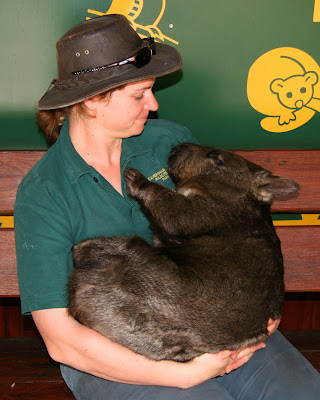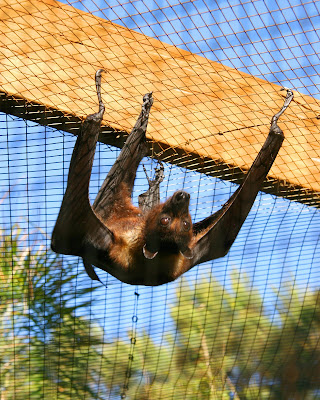By Monday our time in Australia was nearing its end. We'd had many wildlife encounters, but I wasn't quite satisfied and Jo was insistent on hugging a Koala Bear, so we headed up North to Caversham Wildlife Park. The gates were locked at the train station due to a rail-workers strike, so we'd have to take the bus. It took almost 3 hours to make the trek to Whiteman Park where Caversham was located. We were starving when the bus dropped us off in the middle of no where which made the mile walk in the bush to Caversham a bit of a mission.

Caversham is a private wildlife park which is home to over 200 species of from all over Australia. They are broken up into geographical areas and most are free to roam in a walk-through type environment that maximizes human interaction. In the center is a huge Kangaroo pin where visitors can pet and feed kangaroo's that are used to humans.
We headed to the Koala area first. The Koalas were hanging out on an eye level line of Eucalyptus trunks and branches. There were attendants who replaced stripped branches with new ones as the Koalas ate through the leaves. Koalas spend 16-18 hours a day sleeping and the rest of the time eating because eucalyptus leaves (their sole diet) are very low in nutrients. You could get close, but only touch with supervision as Koalas can be violent if provoked or threatened especially when with a baby.

Jo and I were very cautious and respectful when touching the Koalas, but other visitors were not. I'm not sure if it was a language issue, but a non-English speaking group from Asia were completely ignoring the warnings from the attendants.

Just after the picture below was taken the Koala lashed out at the tourist in a deep growl and I realized why they are called bears. He was aggravated from her constant prodding. Actually they are not bears at all they are marsupials. Europeans called them that because they reminded them of small bears.
The "Wombat Show" was next. It wasn't really a show, just a sleepy Wombat curled up in a park staffers lap. The Wombat is the Koala's closets evolutionary relative. Wombats are large muscular marsupials that burrow underground in large networks of dens. They can be very hostile to intruders and although slow most of the time can run at speeds up to 25 mph.

Later, I found this Wombat in a more natural environment.
The show also included a new born Kangaroo Joey and a rescued Parrot. You could touch the Wombat and the Joey, but the parrot was known to be aggressive to park visitors. I really wanted to touch him, but could tell by the look in his eyes he wasn't having it.
The next stop was a large Aviary featuring wildlife from the Northwest Territories.
Breakfast time for the nocturnal Kangaroos was approaching so we made our way to the large open pin. The pin consisted of a open tree filled fields surrounded by rock walls. Tame Kangaroos and Wallabies roamed freely with guests in the pin and could be fed by hand from bins of food. There was a mix of species in the bin including Red, Grey, and Albino Kangaroo and Wallabies. When we walked through the high double gate most Kangaroos were still sleeping.
Sleeping Joeys
Waking Up
Wallaby
As they woke up the Kangaroos made their way from all directions to the feed areas. Hopping on their large rear feet Kangaroos can reach a top speed of over 40 mph. This is used more as a means to search for food than escape predators. Their large rear feet are too big to walk at slow speeds so they use their tail and front legs to crawl-walk. It's a very unique type of movement that's interesting to watch. Another unique oddity of Kangaroos compared to other herbivores is that they don't fart. Instead of releasing methane (like cows, and yours truly) they recycle fermented digestive gases into more energy. Imagine how much faster I'd be in mountain bike races if I could do that!
Crawl-Walking
Hopping
We grabbed a couple hand fulls of food and soon were surrounded by hungry Kangaroos.
It didn't take long for us to be pinned by Kangaroos against the fence. While Jo enjoyed feeding as many as she could I climbed up on the fence to get a better shot. Sitting at first I couldn't fit all the Kangaroos in the shot, so I climbed higher and balanced myself on the top log. Then one of the funniest moments of the trip happened. With no warning the log collapsed with a loud crack. I fired off a shot just as the log gave way. Jo and the Kangaroos exploded in every direction like someone had thrown a grenade in the middle of the crowd. Everyone who saw it was overcome by deep belly laughter. Five minutes later people were still hunched over in pain from laughing too much. An old dutch man was the worst, he was weasing while clutching his gut unable to stop his laughter.
As I wiped the tears of laughter from my eyes I noticed a distinct Red Kangaroo in a group that had gathered after they sprinted away from us. I grabbed some food and tried to make peace for scaring them. He was cautious at first, but eventually warmed up to me even eating food from my mouth.
Jo was having the time of her life feeding the Kangaroos and I'm sure she was plotting on how to smuggle one home, but it was getting dark and there was more wildlife to see. On the way out of the pin I spotted a Kangaroo head were it didn't belong. It was joey poking out of the pouch of his mother. He was a little leary of me and I didn't want him mom to feel threatened, but food won over fear and soon she was nibbling pellets out of Jo's hand while I got some close ups.
After the Kangaroo pin we wondered around the other geographical areas of the park. We saw Parrots, a variety of Owls, a Blonde Possum, and large bats called Flying Foxes.
There was a leafy display that looked more like America's wooded Northeast than anything I'd seen in Australia. As I was looking down in the seemingly empty display a ball of leaves moved collectively scaring me so bad I almost fell over backwards. It was a spiny anteater officially known as a Echinda. Can you see him?
As I was taking closeups of the anteater I saw a familiar face out of the corner of my eye. It was a Blue-winged Kookaburra. A male and female shared a cage together and were especially cheeky when a park worker tried to feed them. They would sneak up and snatch the fish out of her hand before she could finish crawling in the cage.
Across from the Kookaburras were the Foxes and Dingos. Jo immediately fell in love with the Dingos and had to be torn away from the cage when it was time to go. Orignially thought to be a descendent of the Iranian Wolf the Dingo is now thought to be more closely related to the modern dog. They were hyper and intently focused on the park worker feeding the Kookaburras. Once they realized she didn't have food for them, they their evolutionary lineage showed as they pouted just like our dogs.
It was almost dark and the park was closing, but we managed one last stop by the Tazmanian Devils on the way out. The Tazmanian Devil is a carniverous marsupial that earned its name due to its stocky muscular shape, dark fur, loud and disturbing screems, and a furiousness when eating. It even emitts an offensive odor when stressed. The devil we saw didn't demonstrate any of that. He was pretty calm and peaceful, but I suspect this was because he had just woke up.
Satisfied that we'd had our fill of Australian wildlife, we were the last ones out of the park. As my posts only seem to get longer, I'm sure you've had your fill too so end the tale of Caversham here!!
































































No comments:
Post a Comment